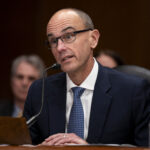As it reported a net loss in the second quarter of about $97 million, Kemper Corp. said Monday that it is exiting the preferred home and auto insurance market.
Kemper said it will “actively reduce the business immediately,” and nonrenew or cancel policies sold through its Kemper Personal Insurance brand. The move will allow the redeployment of over $300 million in capital to Kemper’s core segments, added Chief Financial Officer Jim McKinney during a conference call on earnings.
“This will simplify the business and enhance capital deployment efficiency,” he said. “As a result, starting in the third quarter, our segment reporting will only reflect our specialty P&C and life and health businesses.”
Eight underwriting companies handled the Kemper’s preferred home and auto business, comprising about $500 million of written premium. Kemper Auto, the company’s specialty auto business, and Kemper Life will not be impacted.
Kemper last November said the preferred business was under strategic review. The second-quarter loss included a $45.5 million after-tax goodwill impairment charge related to the review, the company said.
Kemper said that during the second quarter it improved its underlying combined ratio in the preferred insurance segment to 95.3 compared to 105.3 during the same quarter a year ago due to rate increases and other underwriting actions. The net operating loss in the segment was reduced to $2.7 million from $16.8 million in Q2 2022. Kemper’s specialty P&C insurance segment also posted a reduced Q2 net operating loss — $10.8 million compared to nearly $39 million in 2022.
President and CEO Joseph P. Lacher Jr. opened the earnings call by saying the industry is dealing with “the most disrupted personal lines environment we’ve ever experienced” as models to predict market behavior “are producing patterns outside their historical norms.”
“A few examples include buying triggers, price elasticity, changes in driving patterns, propensities to file claims seeking medical treatments and repair vehicles, and the willingness to litigate,” he said. “These pattern changes are exacerbated by subsequential broad swings in competitors’ actions. We believe this environment will continue for at least the next couple of years.”





















 The Future of Knowledge in Insurance: From Training to AI-Powered Productivity
The Future of Knowledge in Insurance: From Training to AI-Powered Productivity  McKinsey Plots Thousands of Job Cuts in Slowdown for Consulting Industry
McKinsey Plots Thousands of Job Cuts in Slowdown for Consulting Industry  Rebuilding Negotiation Talent: Why This Skill Is Missing and How to Fix It
Rebuilding Negotiation Talent: Why This Skill Is Missing and How to Fix It  How Carriers Are Pairing AI and Process Discipline to Drive Subrogation Outcomes
How Carriers Are Pairing AI and Process Discipline to Drive Subrogation Outcomes 




